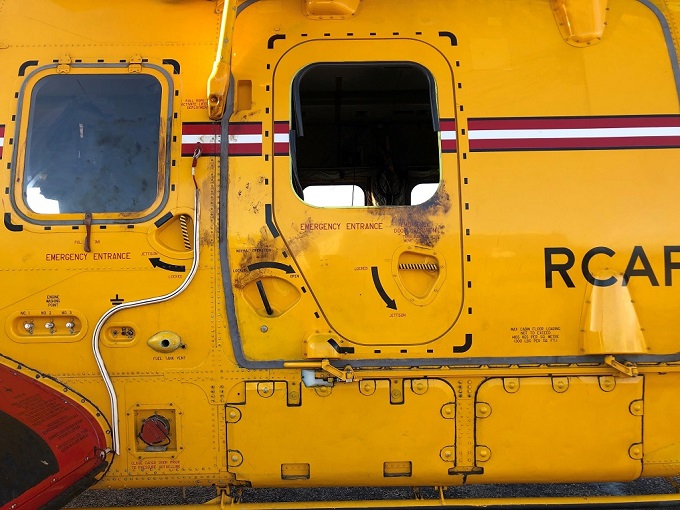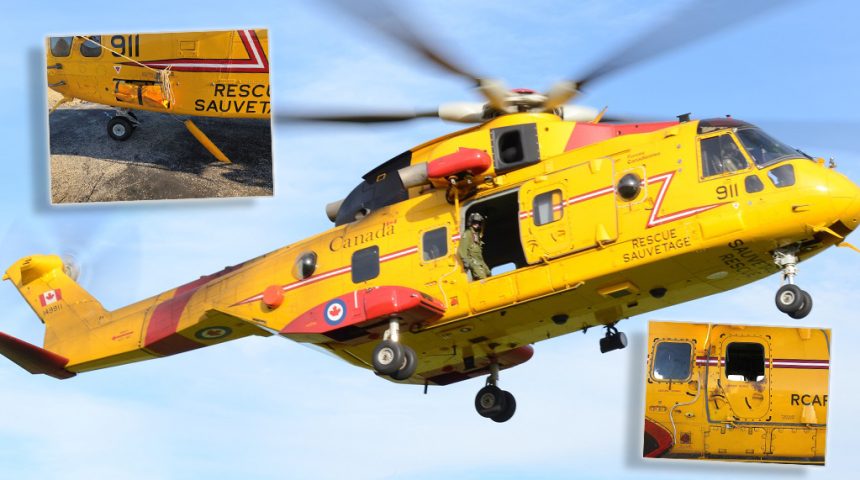The episode happened after the crew had to divert because of adverse weather and the helicopter was parked at a remote airfield.
An unusual incident happened on Sept. 16, 2020, when a polar bear damaged CH-149 Cormorant, serial 149911, of the Royal Canadian Air Force. The helicopter, which belongs to the 413 (Transport and Rescue) Squadron at 14 Wing Greenwood, was performing a planned two-week mountain flying search and rescue exercise and diverted to Saglek airfield in Labrador after poor weather prevented the aircrew from landing at their preferred location, according to a Twitter post of the RCAF.
1/3
On September 16, a CH-149 Cormorant crew with 413 (Transport and Rescue) Squadron at 14 Wing Greenwood parked its helicopter at the Saglek, Newfoundland and Labrador, airfield after poor weather prevented them from landing at their preferred location. pic.twitter.com/vYC5V1vE11
— Royal Canadian Air Force (@RCAF_ARC) September 30, 2020
3/3
The polar bear did not get inside the helicopter and there were no crew members in the vicinity at the time. After an inspection, repairs were completed and the crew resumed flights on their planned two-week mountain flying search and rescue exercise.
— Royal Canadian Air Force (@RCAF_ARC) September 30, 2020
According to a statement released by Lt.Col. Brent Vaino, the squadron commander, to CBC/Radio Canada, the preferred location where the helicopter was headed was a nearby automated radar station, about 4 km from the airfield and at higher altitude, but because of the weather they had to land at the airfield which is closer to sea level.

The radar station, known also as Canadian Forces Station (CFS) Saglek, was built in the 1950s by the U.S. Air Force together with the airfield. After the US transferred the control of both locations to the Canadian Forces, the station obtained new radars and was added to the North Warning System, a joint U S and Canadian early-warning radar system for the atmospheric air defense of North America operated and maintained by North American Aerospace Defense Command (NORAD). The radar installation is listed as “minimally attended”, while Saglek airfield is listed in the Canada Flight Supplement as abandoned.
Lt.Col Vaino explained: “The crew had to park the aircraft down below, not up at elevation like they wanted to. Because of that, it’s an area with a body of water on either side and polar bears do occasionally transit on either side of them, and this case that’s what happened.”
The perils of flying in the north!
A curious polar bear damaged an @RCAF_ARC Cormorant at Saglek airport in Labrador last week! pic.twitter.com/LMpH0fVUgu
— Mike Bechthold (@mike_bechthold) September 28, 2020
Normally, a security detachment travels with the helicopter however, to reduce the risk of exposing the remote community to COVID-19, the number of military personnel on the training mission was restricted. During the night, while the crew was sleeping at the radar station, the curious polar bear began to investigate the helicopter. The RCAF stated that the bear caused “superficial damage”, popping an emergency entrance window on the right side door, another emergency entrance window on the rear left side and the cover of what should be the emergency floatation device on the left side, just below the cockpit.

As stated by the RCAF, the bear did not get inside the helicopter and the crew was unarmed as they were not in the vicinity of the helicopter. According to CBC, the repairs took four days because of the adverse weather that prevented an unspecified RCAF fixed wing aircraft from delivering the replacement parts to Saglek. After another helicopter delivered the spares, the Cormorant was finally repaired and flown out of the remote location.









